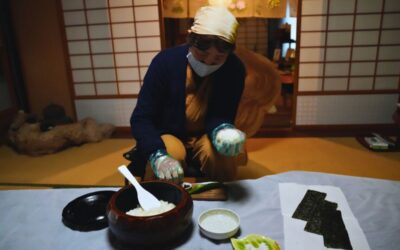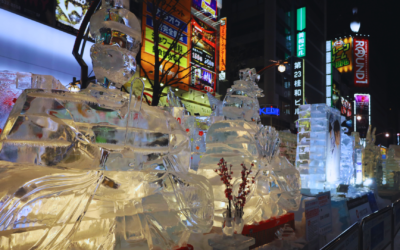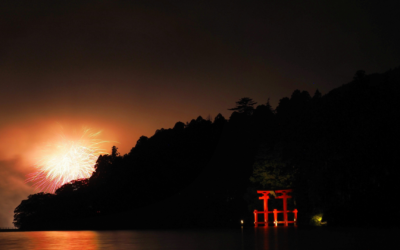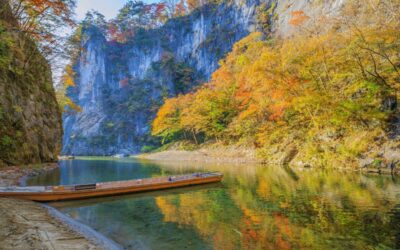Hinamatsuri, also known as the Doll’s Festival, is celebrated on March 3rd. It’s a beautiful tradition where families wish for the health and happiness of girls. But how long do Hina doll decorations stay up? What food is eaten on this special day? Let’s explore the customs, decorations, and ways to enjoy Hinamatsuri events!
What is Hinamatsuri?
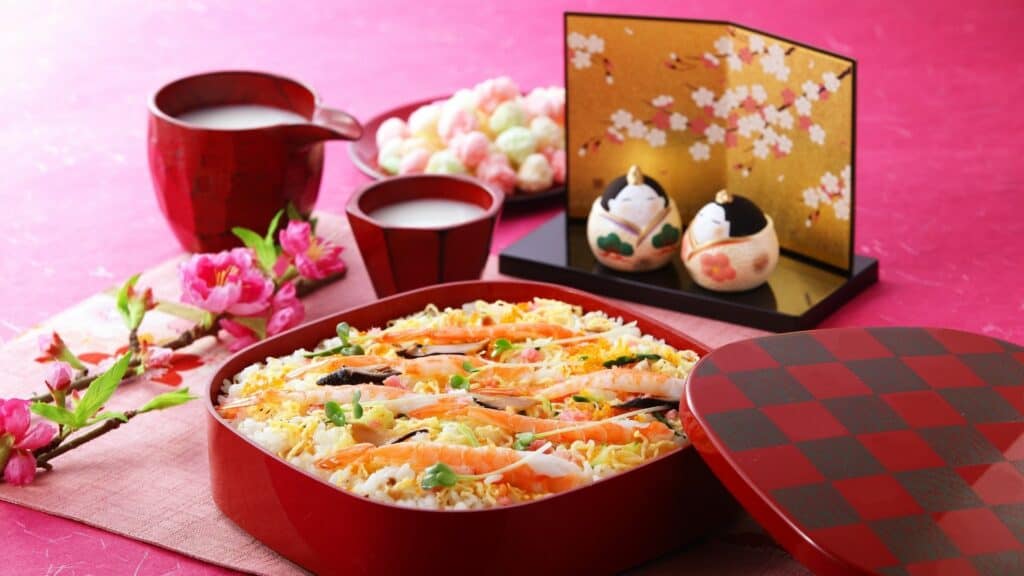
Hinamatsuri is a festival to wish for the well-being and growth of girls. Traditionally, it was called the Peach Festival (桃の節句, Momo no Sekku) because peach trees start blooming around this time.
Why is Hinamatsuri on March 3rd?
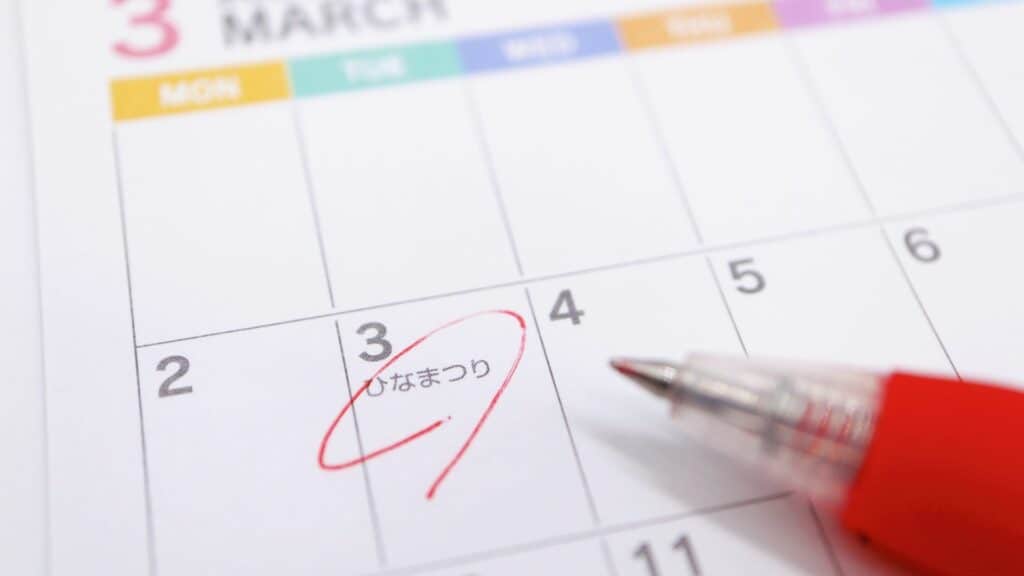
In ancient China, the Onmyōdō (陰陽道) belief system considered days where odd numbers overlapped (1st, 3rd, 5th, etc.) as special. March 3rd was linked to the Double Third Festival, similar to Japan’s Tanabata (July 7th) and Dragon Boat Festival (May 5th).
During the Heian period, Japan adopted this tradition, and by the Edo period, it became an official holiday called “Gosekku.”
Hinamatsuri is a rather important holiday, and it has a lively festival atmosphere.
Where Did Hinamatsuri Decorations Come From?

You may have seen Hina dolls representing royal court figures. This tradition dates back to a noble children’s game called “Hina Asobi” (ひいな遊び), mentioned in The Tale of Genji.
Later, noblewomen who married samurai brought Hina dolls as wedding gifts, and the dolls became a symbol of prosperity among samurai and wealthy families.
Hinamatsuri and Peach Blossom
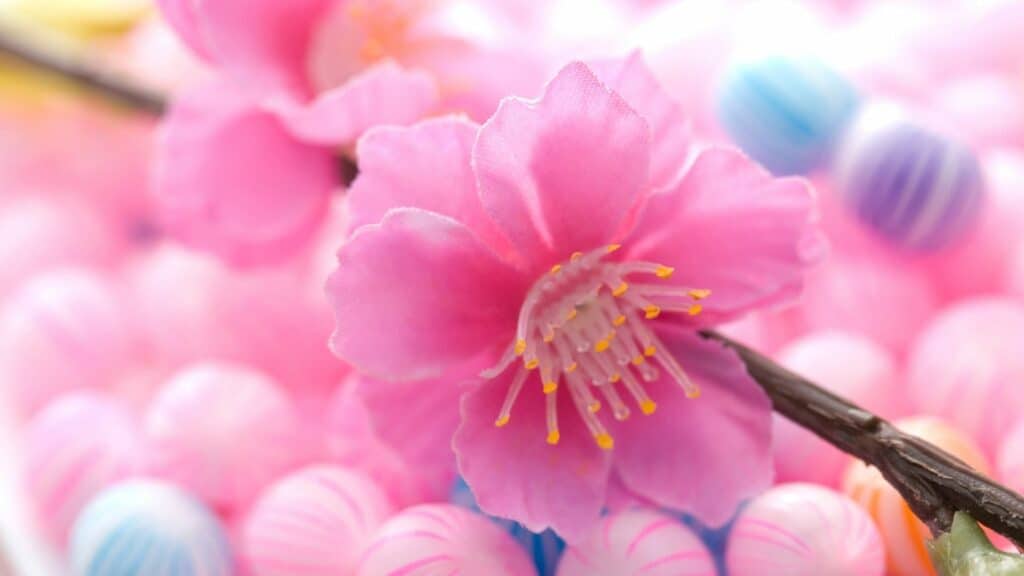
Since March marks the arrival of spring, this festival is also called the Peach Festival. In Chinese traditions, peach trees are believed to have protective powers against illness and misfortune.
How to Decorate with Hina Dolls
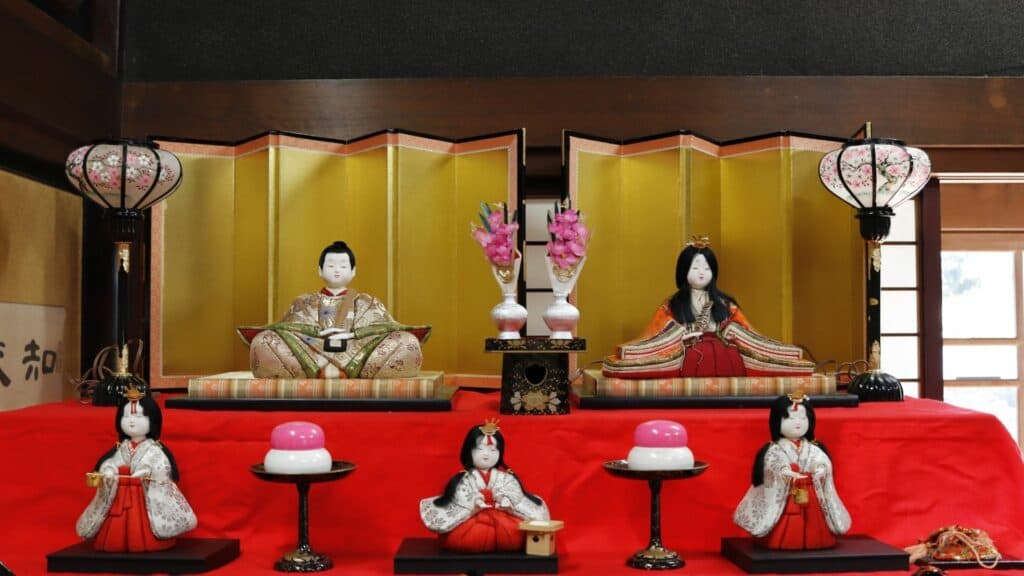
There are two main types of Hina dolls:
- Kyobina (Kyoto-style): Male doll sits on the left, female on the right. Features soft, subtle expressions.
- Kanto Hina (Tokyo-style): Male doll sits on the right, female on the left. More defined facial features.
Different Hina Doll Arrangements
1️⃣ Seven-tiered display (Most elaborate) – Includes 15 figures, representing the royal court:
- Top tier: Emperor & Empress
- 2nd tier: Three court ladies
- 3rd tier: Five musicians
- 4th tier: Two ministers
- 5th tier: Three servants
- 6th & 7th tiers: Wedding tools (dressing boxes, ox carts)
2️⃣ Five-tiered display – Follows the same order but omits some accessories.
3️⃣ Three-tiered display – Groups the attendants together, often including wedding tools.
4️⃣ Two-person display (Imperial Prince Set) – A simple Emperor & Empress setup, common in the Muromachi period and still popular today.
When to Decorate with Hina Dolls

Most people start decorating with Hina dolls around Lichun (Setsubun, February 3rd) and keep them up until March 3rd.
Another lucky time to put up Hina dolls is on Usui (around February 18th), one of Japan’s 24 solar terms. This day marks when snow starts melting into rain, symbolising new life, fertility, and prosperity.
No matter when you choose to decorate, it’s best to do it at least a week in advance. Avoid putting them up on March 2nd, as decorating overnight (一夜飾り, Ichiyakashiri) is thought to bring bad luck.
When taking Hina dolls down, pick a sunny and dry day before mid-March to prevent moisture damage. Some believe it’s best to clean up on Keichitsu (啓蟄), around March 5th.
What to Eat for Hinamatsuri
Eating special Hinamatsuri foods is said to bring extra good luck along with the Hina dolls!
Chirashizushi
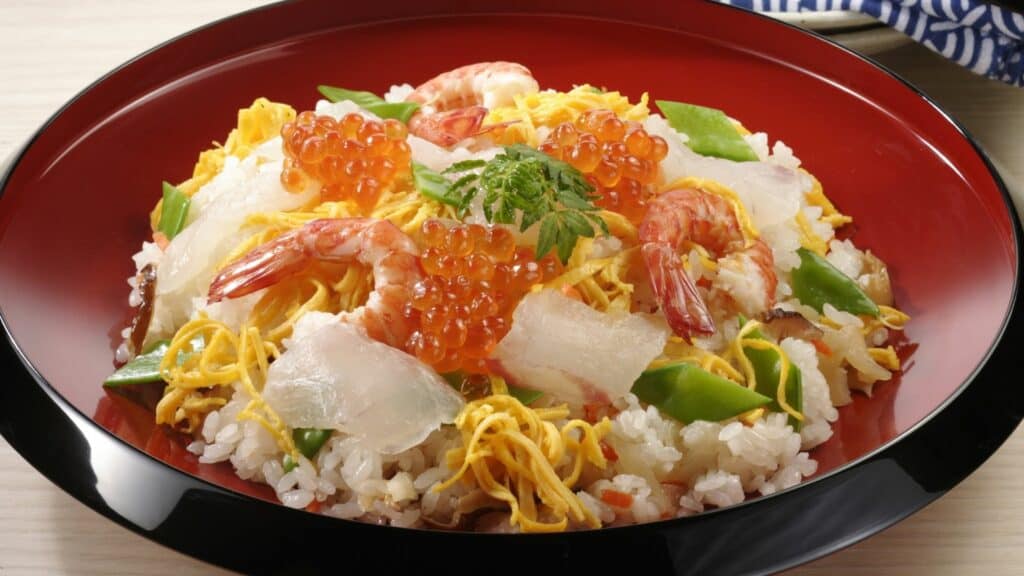
A festive sushi dish with various colourful toppings. Traditional Hinamatsuri toppings include:
- Green beans → Symbolise a strong work ethic and perseverance.
- Egg, shrimp & fish roe → Represent prosperity and happiness.
If cooking isn’t your thing, you can easily find Chirashizushi at supermarkets!
Clear Clam Soup

This simple yet meaningful dish is made with clam shells that fit perfectly together, representing a happy and faithful marriage. A must-try for good luck in love! 💕
Hina Arare
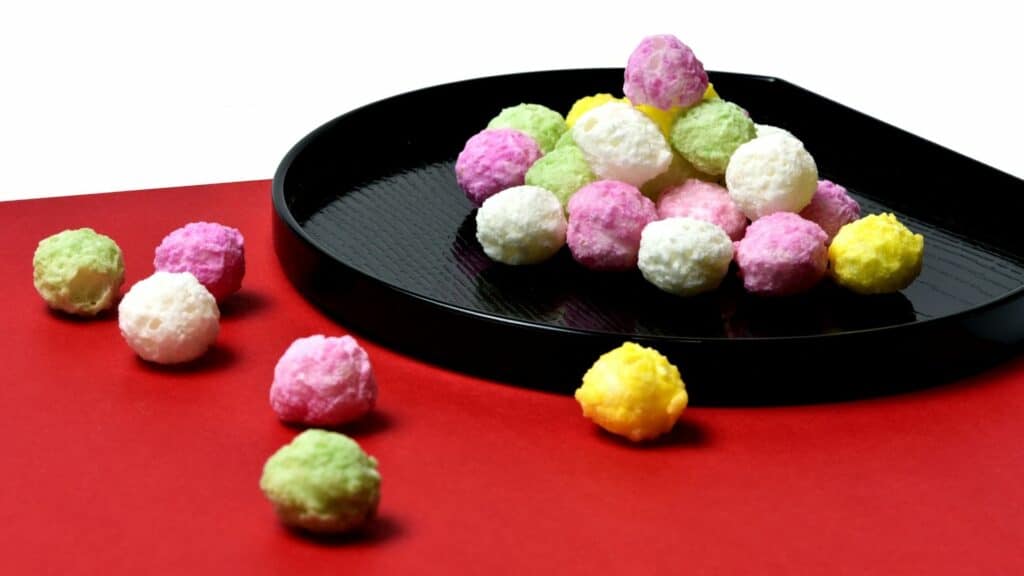
The most famous Hinamatsuri snack, these crunchy, colourful rice crackers come in two variations:
Four colours (white, pink, green, yellow) → Symbolise the four seasons, ensuring happiness all year round.
Three colours (white, pink, green) → Represent energy from earth, life, and trees, bringing good health for the year.
Hishi Mochi

A tri-coloured mochi with each layer bringing different blessings:
- Pink → Protection & good health (coloured with gardenia extract).
- White → Purity & longevity (made with water chestnut).
- Green → Vitality & growth (flavoured with yomogi, a Japanese herb).
Shirozake & Amazake (Sweet Sake)
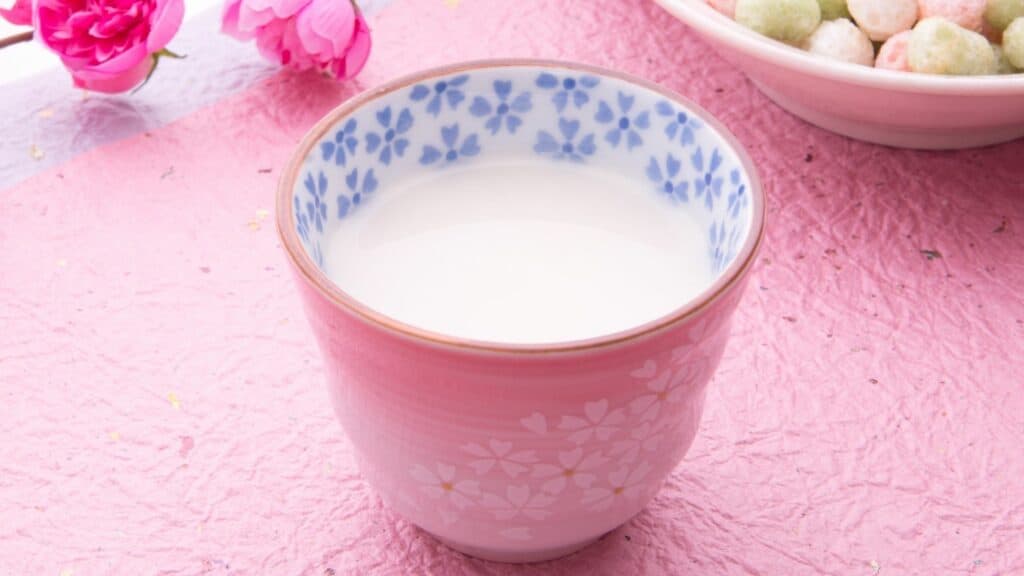
Shirozake is a fermented sake traditionally enjoyed by adults on Hinamatsuri.
For children, there’s Amazake, a non-alcoholic version, so everyone can join the toast! 🍻
Hinamatsuri Events
Ningyo Tonomachi Iwatsuki Machikado Hinameguri, Saitama
During the Edo period, Hina dolls were expensive, so families made small dolls using fabric like brocade, yuzen, and crepe. This festival lets you experience traditional doll-making, just like they did in the past. You can also visit the Iwatsuki Doll Museum, which opened recently, and explore rare Hina dolls displayed throughout the town.
A special Hinamatsuri-themed lunch menu is also available, making this an immersive way to enjoy the festival. If you love hands-on cultural experiences, this is a must-visit!
Awa Katsuura Big Hina Festival, Tokushima
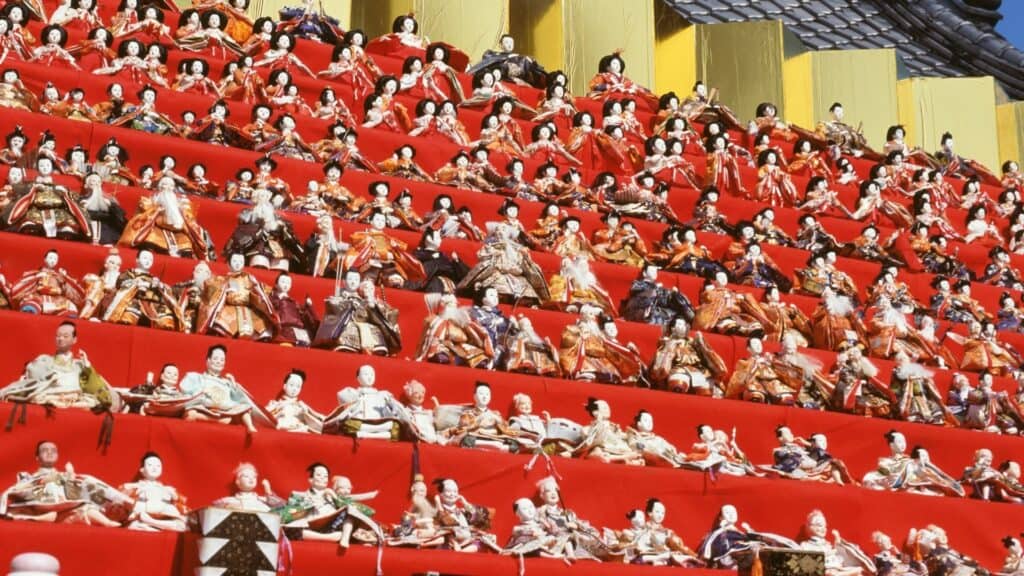
One of the most visually stunning Hinamatsuri celebrations, this event features an awe-inspiring display of 30,000 Hina dolls, collected from all over Japan. The centerpiece? A massive pyramid of dolls arranged on stairs, showcasing intricate craftsmanship and tradition.
This year, the festival collaborates with the Sakamoto area, where visitors can take a guided tour of historic sites, shops, and shrines, all decorated with unique Hina dolls. It’s a fantastic blend of tradition, sightseeing, and culture!
Yanagawa Hina Matsuri Sagemon Tour, Fukuoka
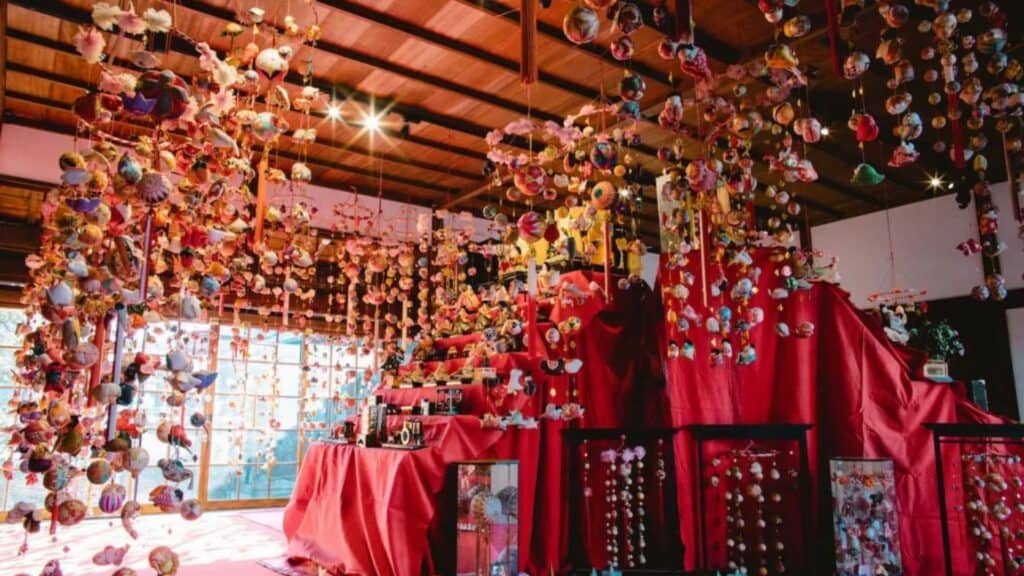
Yanagawa’s Hinamatsuri Sagemon Tour is unlike any other—here, the festival is celebrated with elegant riverboat rides through the town’s historic canals. Locals hang colourful Sagemon (decorative ornaments) in homes and shops, creating a vibrant, festive atmosphere.
With its picturesque scenery, cultural events, and unique way of celebrating Hinamatsuri, this is one of Japan’s most charming spring experiences!
Hyakudan Hinamatsuri, Hotel Gajoen, Tokyo
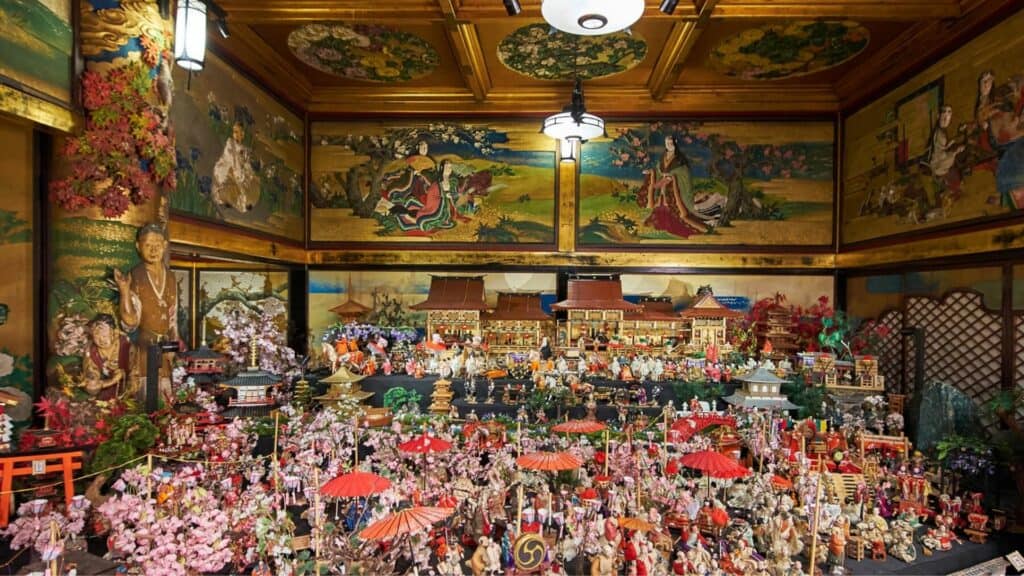
Held in Hotel Gajoen’s historic Hyakudan Kaidan, this festival showcases stunning, multi-floor displays of Hina dolls, each with its own regional style and history. Every floor is uniquely decorated, offering visitors a rare chance to see Hina dolls from different eras and prefectures.
Since this is one of Tokyo’s most famous Hinamatsuri exhibits, pre-booking online is recommended to secure your spot and get discounted tickets!
Doll Floating Ceremony, Sumida Park, Tokyo

One of the oldest Hinamatsuri traditions, the Doll Floating Ceremony (Nagashibina) involves placing Hina dolls in small boats and setting them adrift on a river. This ritual is meant to carry away bad luck and bring blessings for health and happiness.
At Sumida Park, the Edo Nagashibina Festival recreates this centuries-old tradition, letting visitors write their wishes on small paper Hina dolls before setting them afloat. It’s a deeply symbolic and spiritual way to experience Hinamatsuri!
Tomo Machinami Hinamatsuri, Fukuyama

Unlike other festivals held at temples or museums, this one is unique because locals in Fukuyama’s Tomo district display Hina dolls inside their homes and shops, allowing visitors to walk around and admire personal collections.
Since Tomo town has many Edo-period houses, strolling through its historic streets while viewing generations-old Hina dolls feels like stepping back in time. This festival offers a rare, intimate look at Japan’s Hinamatsuri traditions within a real community setting.
Ceramic Hina Doll Festival, Arita

Unlike traditional fabric or wooden Hina dolls, the ones here are made of delicate porcelain, reflecting Arita’s 400-year-old ceramics tradition. The event includes:
🏯 Exhibitions of handcrafted ceramic Hina dolls in various artistic styles.
🌸 Cherry blossom viewing, making for a picturesque spring experience.
🔖 Stamp rally – Explore 30 different locations, sightseeing while collecting stamps to support local businesses.
Kasuisai Doll Festival, Shizuoka
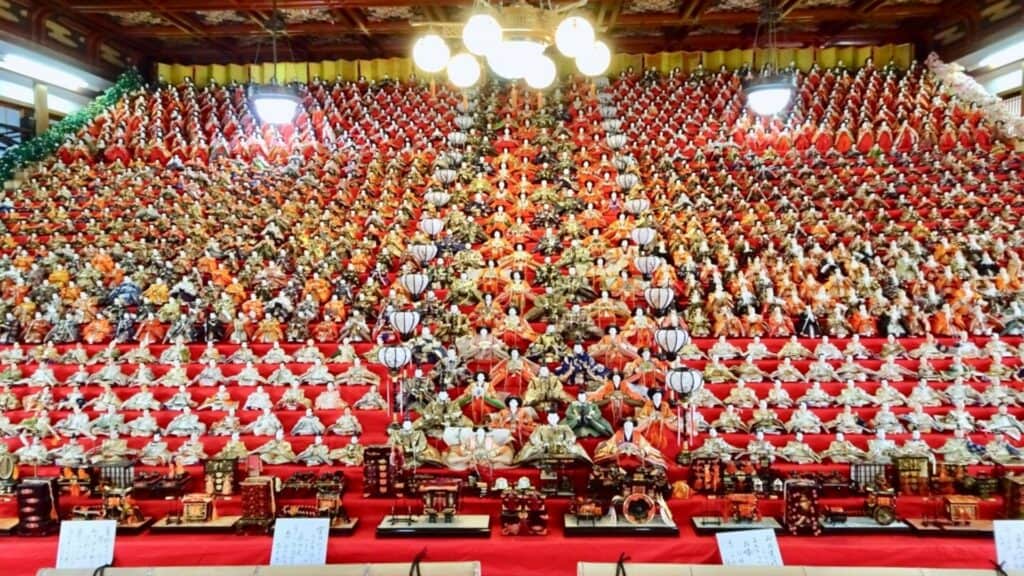
Home to Japan’s largest Hina doll display, Kasuisai Temple features a grand staircase covered in thousands of dolls, creating a breathtaking spectacle.
Visitors can also:
🍵 Experience Shojin Ryori, the traditional Buddhist vegetarian cuisine, available by reservation.
🙏 Participate in prayers and rituals for prosperity and well-being.
Celebrate the Beauty and Meaning of Hinamatsuri
Hinamatsuri is more than just a day to display beautiful dolls—it’s a festival filled with cultural significance, family traditions, and unique local celebrations. Whether you’re floating Hina dolls down a river, admiring intricate displays, or indulging in festive foods, there’s a special way for everyone to experience it.
With so many incredible events across Japan, will you be celebrating Hinamatsuri this year? Which tradition or festival interests you the most? Let us know in the comments! 🎎🌸



